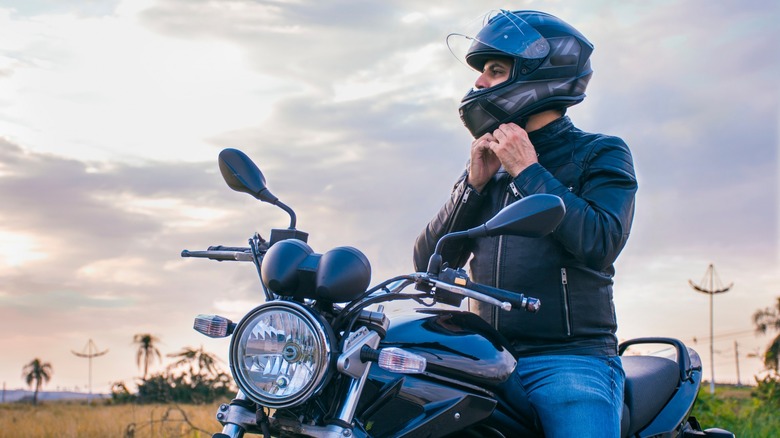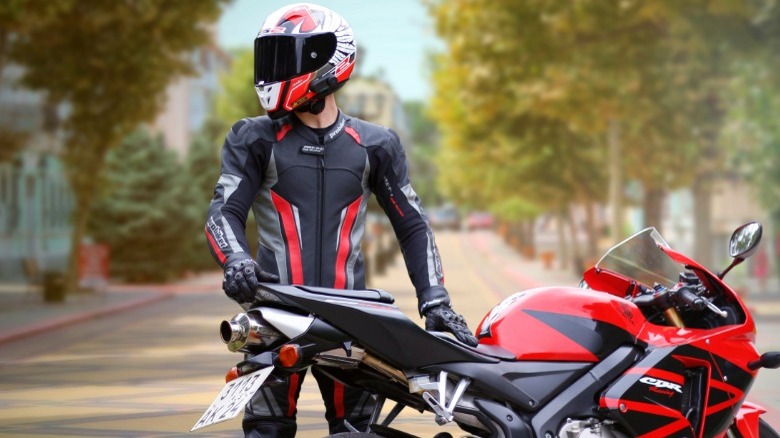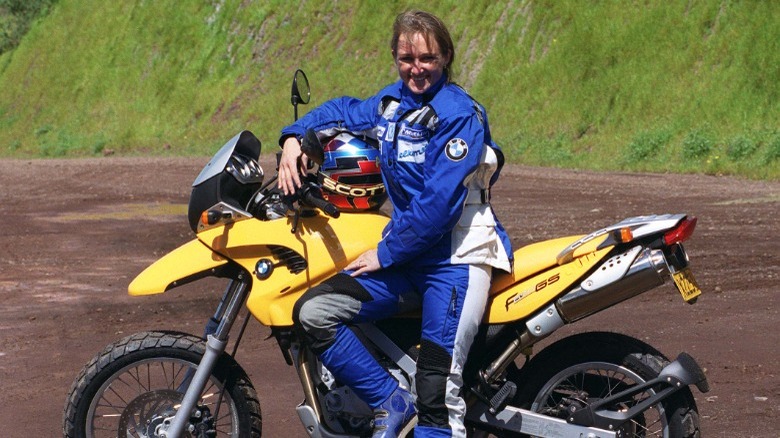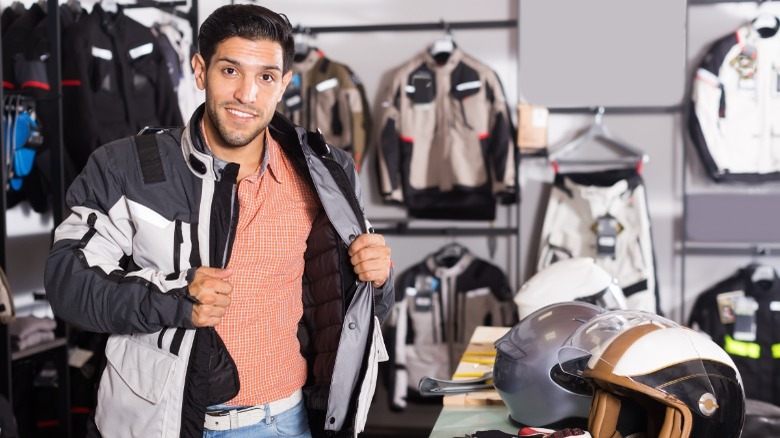Everything You Need To Consider Before Buying A New Motorcycle Jacket
If there's one thing people associate with motorcycling, it's danger, and that's not entirely an incorrect association, given just how fast motorcycles go, and just how unprotected motorcyclists are when they're on the streets. There are no crumple zones, air bags, or safety belts to protect riders from going head-first into traffic in the event of a collision. This perception isn't entirely incorrect, either, with 5 percent of highway-related fatalities, even though motorcycles only account for 3% of the vehicles on the road.
For this reason, it's important to invest in proper safety gear. Usually, just after a helmet, gloves, and boots, you'll hear people recommend you buy a top-of-the-line riding jacket. A good, well-provisioned jacket can help keep you safe, but there's more to protection than just loading up on armor and calling it a day. You need to make sure you select the correct fit, material, and amount of protection so that your jacket is not only protecting you, but is also practical to wear for the duration of your ride.
Buy the right type of jacket for your ride
When it comes to motorcycle jackets, there are a great many to choose from, and which to buy depends entirely on your ride. If you're frequently in high-speed traffic on the freeway, you'll want a jacket that's loaded with protection, but compromises a little when it comes to ventilation. On the other hand, if you're frequently doing slower, more arduous trips through bumper-to-bumper traffic, you might want to compromise on the rigidity of the padding in order to get a more breathable, flexible, comfortable jacket, or a riding shirt.
The fit of the jacket also impacts how comfortable you're likely to be. A race jacket that's pre-bent at the elbows isn't going to be the best for upright riding, while a slim European cut jacket probably won't suit you particularly well if you need extra room for additional layers or comfort. If you've tried a European fit and find it too tight, look for something with an American or Touring cut instead, as they often don't taper as much towards the waist, and offer a more roomy fit, in general.
Choosing the correct level of protection and the correct fit for your jacket is challenging, because different weather conditions and different types of rides call for different things. It's downright dangerous to be stuck in a sweaty racing suit on a four-hour adventure ride, but you also don't want a lack of protection when you inevitably do take a spill. Material choices can also play a role when it comes to protecting you from spills and the elements.
Choose the right material for your application
Generally speaking, motorcycle jackets are broken up into two categories: textile and leather. Textile jackets don't offer as much protection as a leather track jacket, but a good textile jacket should be sufficient for the majority of riders, especially if you're just puttering around on city streets or commuting to and from work. Leather is the gold standard when it comes to protection, so it's no surprise that MotoCAP's safest jackets are all leather. If you like to go fast but want to stay safe, a good kangaroo, buffalo, or even cow leather jacket is going to be the go-to option. Thicker leather is less flexible, meaning it will be hotter and fatigue you more on longer rides, while thinner leather compromises on protection in the name of flexibility and weight.
Motorcycle jacket textiles themselves offer a lot of variety, and each has its own advantages and disadvantages. Kevlar is the go-to fiber if you want to go fast, but check the Kevlar content to make sure that it isn't being used just for marketing, since some brands will add Kevlar to their jackets because of its popularity. Aramid and Cordura Nylon offer about the same if not slightly more abrasion protection than Kevlar, but some tracks and race organizations only allow certain textiles. If you want to do track days, check your local track rules before buying gear.
Longer days in the saddle in hotter climates are going to call for ventilation, and perhaps something like a mesh jacket with a reasonable amount of protection. If you know you'll be riding in slower traffic and in hot weather, a mesh jacket with armor may be the way to go, while materials like Gore-Tex and Aero-Tex, among others, are waterproof for rainy days.
Make sure your jacket fits just so
As important as selecting the correct material and correct type of jacket is making sure that your jacket fits you. Most reputable brands, like Icon, have some sort of size chart that translates chest and sleeve measurements to a size. Be sure to follow the measurement instructions on the sizing chart, because that's how the brand will have designed the jacket to fit. Aside from chest and sleeve measurements, it's important to try on a jacket before you buy it to make sure it fits snug, but doesn't impede your mobility too much.
Unfortunately, the need to try on your jacket means that buying a jacket online might not be the best bet, even if many sites do offer generous return policies. If you are buying online, be sure to check out the return policy beforehand, and talk to a customer service representative if you need a sizing chart or guidance. It's better to take your time and get gear that fits and is fit for purpose the first time than to waste time with returns or fit issues.



